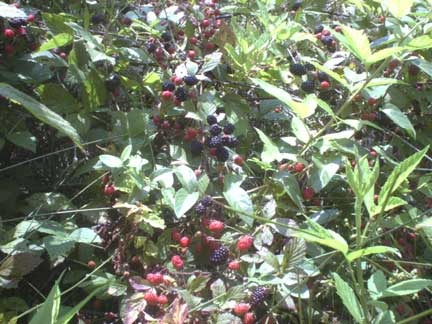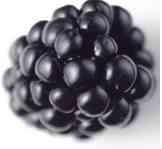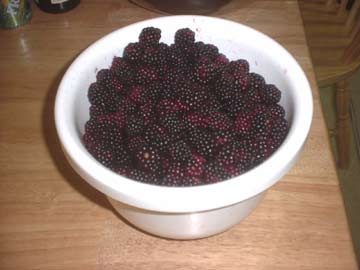
Looking for Blackberry Facts and Picking Tips in 2025? Scroll down this page and follow the links. And if you bring home some fruit or vegetables and want to can, freeze, make jam, salsa or pickles, see this page for simple, reliable, illustrated canning, freezing or preserving directions. There are plenty of other related resources, click on the resources dropdown above. If you are having a hard time finding canning lids, I've used these, and they're a great price & ship in 2 days.
If you have questions or feedback, please let me know! There are affiliate links on this page. Read our disclosure policy to learn more.
What's in season in August 2025, and other timely information:
Notes for August 2025: Spring is here! Strawberry season is here. It started in February in Florida, Texas, southern California and a few other areas of the Deep South; then March along the Gulf coast, April in the Deep South and west coast, May through much of the country, and June in northern areas. Blueberries are next, about a month later. Of course, cool weather crops, like Rhubarb, asparagus and greens should be available almost everywhere. Check your area's crop calendar (see this page) and call your local farms for seasonal updates.
You may also be interested in finding a local:
- Children's Consignment Sale happening now; save money on children's clothes, toys, books, etc, find a local children's consignment sale, also often held by churches in the Spring and Fall, click here!
- Fun factory tours - usually free, fun and educational, find them in every state here!
- Road trip or a Camping trip - Find free and low-cost, but fun, interesting places to visit and things to do and see!
Are carpenter bees boring holes into your house, shed or barn? There is a simple non-toxic solution!
NEW! Start your own tomato, pepper, squash and other vegetable plants from seed - It's easy and
costs about 50 cents per plant.
Also see our Master list of tomato varieties,
with descriptions, details and links to ordering the seeds.
We also have home canning, preserving, drying and freezing directions. You can access recipes and other resources from the drop down menus at the top of the page or the site search. If you have any questions or suggestions, feel free to write me! It is easy to make your own ice cream, even gelato, or low fat or low sugar ice cream - see this page. Also note, there are many copycat website listing U-pick farms now. They have all copied their information from here and usually do not ever update. Since 2002, I've been updating the information every day but Christmas; so if you see anything wrong or outdated, please write me!
Blackberry Facts and Picking Tips
Blackberry Facts and Picking Tips
 In
the U.S. Blackberries typically peak during June in the South, and in July in
the North. Crops are ready at various times of the month depending on which part
of the state you are located. In order to produce good local Blackberries,
producers depend on ideal spring and early summer weather conditions.
See this page for a list of
blackberry festivals around the U.S.And see this page for a complete list of blackberry varieties
In
the U.S. Blackberries typically peak during June in the South, and in July in
the North. Crops are ready at various times of the month depending on which part
of the state you are located. In order to produce good local Blackberries,
producers depend on ideal spring and early summer weather conditions.
See this page for a list of
blackberry festivals around the U.S.And see this page for a complete list of blackberry varieties
Blackberry Facts and Tips
-
 Blackberries, also known as "black caps" are a very healthy food;
packed with anthocyanins!
Blackberries, also known as "black caps" are a very healthy food;
packed with anthocyanins! - The USDA says 1 cup of blackberries has about 62 calories.
- 1 cup of blackberries, not packed down weighs about 140 grams.
- Select plump, firm, fully blackberries. Unripe berries will not ripen once picked.
- MD Anderson Article Regarding Their Prevention of Cancer
- Oregon Berry Blackberries information
- Blackberry tea was said to be a cure for dysentery during the Civil War. During outbreaks of dysentery, temporary truces were declared to allow both Union and Confederate soldiers to "go blackberrying" to forgage for blackberries to ward off the disease.
- Blackberries were enjoyed by the ancient Greeks, who believed them to be a cure for diseases of the mouth and throat, as well as a preventative against many ailments, including gout.
- The blackberry leaf was also used as an early hair dye, having been recommended by Culpeper, the English herbalist, to be boiled in a lye solution in order to "maketh the hair black".
- Guide to blackberry varieties
- Researchers have known for quite some time that berries contain antioxidants which help to fight cancer causing free radicals. A study at the University of Ohio has found that blackberries are the most potent cancer fighting berries of them all, by nearly 40 percent!
- U-pick Blackberry farms typically sell berries by the pound. A quart equals 1 and 1/2 pounds of fresh berries.
- Do the math and be careful not to over-purchase as Blackberries quickly mold when left at room temperature, and only last a couple of days in the refrigerator.
- You can easily freeze berries that you cannot use right away - just wash, cut the hulls off and pop them into a ziplock bag, removing as much air as possible. Those vacuum food sealers REALLY do a good job of this! The berries will keep for many months frozen without air.
- Want to go to a blackberry festival? See this page for a list!
Before you leave to go to the farm:
- Always call before you go to the farm - And when they are in season, a large turnout can pick a field clean before noon, so CALL first!
-
 Leave
early. On weekends, then fields may be picked clean by NOON!
Leave
early. On weekends, then fields may be picked clean by NOON!
-
Bring containers - Most growers furnish picking containers designed for Blackberries, but they
may charge you for them; be sure to call before you go to see if you need to
bring
containers.
If you use your own containers, remember that heaping Blackberries more than 5 inches deep will bruise the lower berries. Plastic dishpans, metal oven pans with 3 inch tall sides and large pots make good containers. I like the Glad storage containers like the one at right. - Bring something to drink and a few snacks; you'd be surprised how you can work up a thirst and appetite! And don't forget hats and sunscreen for the sun. Bugs usually aren't a problem, but some deet might be good to bring along if it has been rainy.
Tips on How to Pick Blackberries
- There are two types of blackberries to know about: thorny and thornless! Obviously, the thornless are easier to pick, but some people claim the thorny varieties are sweeter. With the thorny plants, you want to reach into the plant in the gaps, so you don't need to touch anything but the berry you're after, avoiding the thorns.
- A ripe blackberry is deep black with a plump, full feel. It will pull free from the plant with only a slight tug. If the berry is red or purple, it's not ripe yet.
- Repeat these operations using both hands until each holds 3 or 4 berries.Unlike strawberries, blackberries are usually pretty tough, I dump mine into the bucket. Repeat the picking process with both hands.
- Don't overfill your containers or try to pack the berries down.
General Picking Tips
Whether you pick Blackberries from your garden or at a Pick-Your-Own farm, here are a few tips to keep in mind:
- Pick only the berries that are fully black. Reach in between the stems to grab for hidden berries ready for harvest. Bend down and look up into the plant and you will find loads of berries that other people missed!
- Avoid placing the picked berries in the sunlight any longer than necessary. It is better to put them in the shade of a tree or shed than in the car trunk or on the car seat. Cool them as soon as possible after picking. Blackberries may be kept fresh in the refrigerator for up to a week, depending upon the initial quality of the berry. After a few days in storage, however, the fruit loses its bright color and fresh flavor and tends to shrivel.
When you get home
-
 DON'T
wash the berries until you are ready to use them or freeze them. Washing
makes them more prone to spoiling.
DON'T
wash the berries until you are ready to use them or freeze them. Washing
makes them more prone to spoiling. - Pour them out into shallow pans and remove any mushed, soft or rotting berries
- Put a couple of days supply into the fridge, wash off the others, drain them and freeze them up! (Unless you're going to make jam right away) Blackberries are less perishable than blueberries or strawberries, but refrigerate them as soon as possible after picking. Temperatures between 34 F and 38 F are best, but, be careful not to freeze the blackberries (while they are in the fridge)!
- Even under ideal conditions blackberries will only keep for a week in a refrigerator, so for best flavor and texture, use them as soon as possible after purchase
Blackberry Recipes, Freezing and Jam directions
- How to make Blackberry jam - It is VERY easy - especially with our free Blackberry jam directions - very easy!
- How to make Blackberry jelly
- How to freeze berries
- Blackberry syrup, make and can it!
- Seedless blackberry pie!
- Blackberry Festivals: Where, When and More to Find an Blackberry Festival Near You this year:
Frequently Asked Questions and Answers About Blackberries
- How to freeze blackberries?
Just rinse them in cold water. I use a large bowl filled with water, pour the berries in, and gently stir them with my fingers to dislodge any dirt or bugs. Then using my fingers like a sieve, I scoop the blackberries out of the water, and put them in a drainer to let the water drain off. Then I just pour the berries into a ziploc bags or vacuum sealer bags and pop them in the freezer. After they are frozen, I remove as much air from the bag as possible and seal the bags. - Soaking in Salt Water? Sinkers or Floaters?
I planted 7 Blackberry bushes 2 years ago and am now in the midst of a lot of ripening berries. Therefor...I'm making jam (along with pies and cobblers). A friend told me that before I eat or cook with them, I should soak the freshly picked berries in the sink full of slightly warm water and a full Tablespoon of salt to remove any parasites (small worms). Have you ever heard of this? Do you know of specific directions to insure all the worms are removed? I've just been rinsing them and using them for the past couple of days. Also, the same friend said that if the berries floated in the water they were "good", but that if they sank to the bottom of the sink I should throw them out. What are your thoughts?
Answer: Well, soaking in salt water sometimes (but now always) causes grubs to dislodge. BUT. in 30 years of growing blackberries in 12 states and 2 continents. I've never seen a bug in a blackberry. But I have heard of folks who do have a problem with pests.If you see bugs in there, give it a try. But until then, save yourself trouble and just wash them in a large bowl of cold water!
Floaters v. sinkers? Naaaahhhh! I've never heard that the density of the berry was a consistent indicator of much other than weather conditions.
- I have picked my blackberries and have seen little worms. Not sure if
these are fruit flys that have laid eggs in them - or if they are grubs. I
picked some out than froze the berries. I have heard that cold will kill
them or drawn them out. If I make jam the cooked way (not freezer jam) and
some of the grubs/worms are left will it hurt people? I would like to
believe I got them all but fear I did not.
Answer: That sounds like some type of fruitworm, the grub or larval form of a beetle. Typically, they are about 1/4-inch long. Soaking for an hour or more in salt water (1 cup of slat to the gallon), may help draw them out. Cold would probably kill them, but leave them inside the fruit. I don't imagine they would be harmful if cooked into jam... but I doubt anyone would ask for seconds if they found one. Eeeewwwwww!
Canning booksCanning and Preserving for Dummies by Karen Ward click here for Canning and Preserving for Dummies by Karen Ward |
|
The All New Ball Book Of Canning And Preserving: Over 350 of the Best Canned, Jammed, Pickled, and Preserved Recipes Paperback - May 31, 2016This is THE book on canning! My grandmother used this book when I was a child. It tells you in simple instructions how to can almost anything; complete with recipes for jam, jellies, pickles, sauces, canning vegetables, meats, etc. If it can be canned, this book likely tells you how! Click on the link below for more information and / or to buy (no obligation to buy) Click here for more information about the Ball Blue Book of Preserving |
Looking for canning equipment and supplies?
Water bath canner with a jar rack
Pressure canners for gas, electric and induction stoves: Presto 23Qt or T-fal 22Qt
Canning scoop (this one is PERFECT)
Ball Blue book (most recent version)
Jars: 8oz canning jars for jams
Find Other types of farms:
Farm markets and roadside stands
Road trips and camping resources
Local Honey, apiaries, beekeepers
Consumer fraud and scams information
Home canning supplies at the best prices on the internet!
Maple Syrup Farms, sugarworks, maple syrup festivals
Environmental information and resources
Farms For Your Event for birthday parties, weddings, receptions, business meetings, retreats, etc.
Festivals - local fruit and vegetable festivals
Get the
most recent version of
the Ball Blue Book
With this Presto 23 quart pressure canner and pressure cooker, you can "can" everything, fruits, vegetables, jams, jellies, salsa, applesauce, pickles, even meats, soups, stews. Model 01781

You can make jams, jellies, can fruit, applesauce, salsa and pickles with water bath canners, like this Granite Ware 12-Piece Canner Kit, Jar Rack, Blancher, Colander and 5 piece Canning Tool Set

